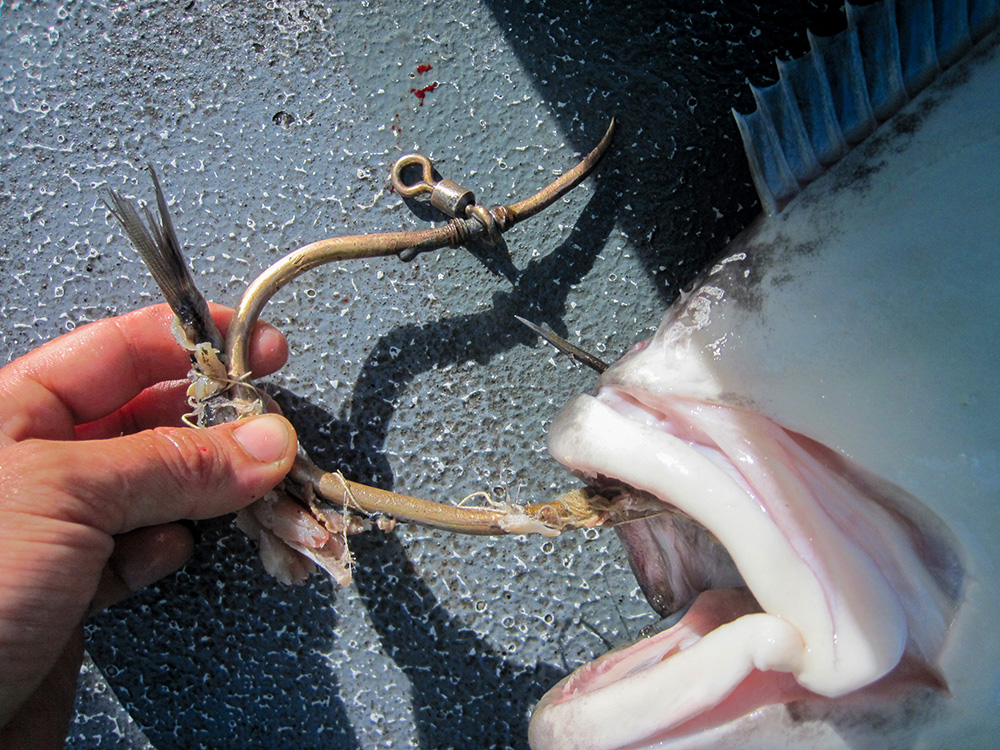In 2011, when then-16-year-old Larry Buzzell took part in a summer internship with Makah Fisheries Management, he knew he wanted to spend his time learning the history of his tribe’s traditional halibut hook — a millennia-old technology that has scarcely been used for a century. The first step, he decided, was to figure out how to make one. Little did he know this summer project would spark a decade of research into the ancient fishing hook — and potentially reveal a long-overlooked key to reducing by-catch in the halibut fishery.
The Makah Tribe’s traditional territory is near Neah Bay, at the northwestern tip of Washington state. Remote from the archetypical salmon-bearing rivers of the Pacific Northwest, Makah anglers were experts at pulling Pacific halibut from the bay. The key to their success was the čibu·d [chi-bood], a hook the Makah spent thousands of years iterating to make halibut-specific.
Made by steaming a single piece of hemlock, fir or yew, then bending it into a U-shape and attaching a bone barb, the hook was a mainstay of the tribe’s fishing practices until the early 20th century.
“And then it almost disappears,” says Joe Petersen, a former groundfish biologist for the Makah Tribe, who now works for the Northwest Indian Fisheries Commission. As modern fishing technologies became more prevalent, including paired circle hooks that could catch more fish, fewer people continued to use the čibu·d.
Jonathan Scordino, a marine mammal biologist for Makah Fisheries Management, was the supervisor at the summer internship program the year Buzzell attended. He says Buzzell’s project came at a perfect time because many of the Elders who had used the traditional hook were getting older and the knowledge was in danger of being lost. “There is knowledge locked in artifacts and in stories, in traditional ecological knowledge, that can be used to address today’s management problems,” he says.
So, over the past decade, the Makah have been studying and refining their historical hook once again. Returning to the summer internship in 2012, Buzzell learned how to make the hook out of brass. His work later became integral to a study, led by Scordino, that compared the catch rate of halibut and other fish using the brass čibu·d to that of the more commonly used paired circle hooks. Scordino and his colleagues found that while the čibu·d catches fewer fish, it is far more specific: the traditional hook is seven times less likely to catch non-target species than the circle hooks.
In Neah Bay, the yelloweye rockfish is a species of concern that the Makah want to avoid hooking. Susceptible to barotrauma and temperature shock if pulled from the seabed to the surface, the fish is considered threatened around Puget Sound and the Salish Sea and is the focus of a rebuilding plan. “And if you’re ever rebuilding a species,” says Petersen, “the absolute best way to help it when you’re fishing is not to interact with it.”
Inspired by their finding, Scordino and his colleagues set out to see if they could make the čibu·d even better. They engaged the community: anyone who wanted to participate was taught how to make a brass čibu·d, using historical pictures of the hook taken from the Makah Museum as a guide. And anyone who had one of the hooks in their personal collection was asked to bring it in. From these sources, they determined the most common measurements, and ended up making about 200 hooks. But since they were handmade, they varied in shape and size. The team, along with volunteers from the community, then went fishing at Swiftsure Bank, a few kilometres northwest of Neah Bay, to test the hooks.
“There was one measurement, which was the tip of the barb to the bottom of that U-shape, that significantly affected how well a halibut hook worked,” says Petersen, who was part of the research team. They found that a distance of 36 millimeters between the barb and the bottom of the u was ideal. When they compared the hook’s catch rate of halibut to that of the paired circle hooks, there was little difference. But the amount of by-catch was still significantly lower. “So it was a much more viable option to use in recreational fisheries.”
Andrea Reid, an Indigenous fisheries scientist and member of the Nisga’a Nation who was not involved with the work, says by-catch is also a major issue in British Columbia. Her research centres on commercial salmon fisheries, and improving survivorship of salmon migrating upstream. “Because [Pacific salmon] co-migrate, they might get caught alongside other populations or species that are of conservation concern.”
Beyond looking at fishing technologies, Reid says Indigenous knowledge and traditional practices can contribute to efforts to reduce by-catch.
She says Indigenous groups fished in areas close to natal streams, so “they could target specific populations, know what they’re fishing, and keep everything that they catch.” But with colonization, there was a huge pressure to shift into marine fisheries, targeting areas filled with all different kinds of fish.
Incorporating traditional technique — as well as traditional technology — could yield additional benefits. Some in the Makah community, says Scordino, suggested that the practice of using octopus as bait could improve catch rates even further — a relationship he is looking into now. “And there are likely other things we haven’t thought about and incorporated,” he adds.
But looking at the record, Scordino says, “these hooks and the way we used them definitely can be useful for today’s management challenges.” ![]()
Read more: Indigenous, Food, Environment
















Tyee Commenting Guidelines
Comments that violate guidelines risk being deleted, and violations may result in a temporary or permanent user ban. Maintain the spirit of good conversation to stay in the discussion.
*Please note The Tyee is not a forum for spreading misinformation about COVID-19, denying its existence or minimizing its risk to public health.
Do:
Do not: